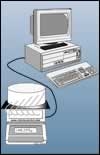COMPLETE SYSTEM FOR SOIL HYDRODYNAMIC CHARACTERIZATION - WIND
What do I measure?
The evolution of the mass of the soil sample, m(t) and thus of θ(t) ; the evolution of the matric potential at 6 different depths, ψ(z,t). With these data, you can calculate the ψ(θ), k(θ) and k(ψ) relationships (curves)
APPLICATIONS
Hydrodynamic soil characterization.

An accurate knowledge of soil characteristics is essential for all researchers studying pollutant transfers through soils or agricultural management practises (modelling irrigation, fertilization, plant protection).
The WIND method has been specifically designed to simultaneously determine the fundamental hydrodynamic soil properties which govern water transfers in soils :
– The matric potential / water content relationship
ψ(θ) curve.
– The hydraulic conductivity / water content relationship
k(θ) curve.
The WIND method is a laboratory method. It consists in submitting a cylinder of soil (collected in the field) initially saturated, to a progressive evaporation and to follow:
– The temporal variation of the mass of soil contained in the cylinder m(t), in order to determine the water loss by evaporation and the average water content of the soil sample.
– The matric potential evolution of the soil sample at different depths ψ(z,t).
I.N.R.A patent
(National Agronomical Research Institute)
METHOD DESCRIPTION
The unit contains six pressure transducers (differential voltage output) and the associated electronic circuit. The six micro tensiometers connected to this unit are introduced into the stainless steel cylinder containing the soil sample. The cylinder is placed on a very precise balance in order to measure its mass variations and determine the water content variations. These data are then related to the soil matric potentials measured with the micro tensiometers over the same period of time. The unit has been designed to eliminate the influence of external disturbing effects (temperatures, pressures, etc.) and ensure very accurate measurements.
TECHNICAL CHARACTERISTICS
Measuring ranges : 0 to -999 HPa
Power supply : 12 volts c.c (9 to18 V possible.).
Output voltage for pressure sensor : 0 to 50 mV. (These values can be different for each sensor. The calibration certificate given with each points the measurement range for each sensors with a great accuracy, and the correspondence hPa (mbar).
Voltage regulator for pressure sensors : 5,00 Volts / 400 mA.
Voltage output : ± 2%.
Line regulation : ± 0,5 % maxi.
Charge regulation : ± 1% maxi. (10-90%).
Residual ripples : (20Mhz pass-band) : 60 mV. typical crest to crest.
Protection against short-circuits : continuous.
Operating temperature : -10°C à +40°C. (WARNING, the centralizing box does not to be at these temperatures.
Temperature of centralizing box : +15°C to + 25°C.
Internal measurement of box temperature : by PT100 class A (3 wire).
Inner resistances network : Welwyn type 15 ppm / 0,1%.
[**] Differential presure sensor :
Offset : 0 ±1,5mV (given by calibration certificate).
Linearity : ± 0,25 (% SPAN).
Repeatability & hysteresis : ±0,20 (% SPAN).
Response time : 1 msec.
Stability over one year : ±0,5 (% SPAN).
Compensated temperature : 0°C to +50°C.
Sensitivity : 6,67mV/psi (0,1mV/mbar).
Overpressure input : + 2,5 bars.
Precision balance : in option
The standard set
The WIND system contains :
– a unit equiped with 6 differential pressure transducers & 6 microtensiometers (ceramic ref. SDEC 220) mounted on 1m of capillary.
– A preparation syringe for the microtensiometers.
You also need
. A datalogger, type Cambell CR10X, a power supply cable for connection Wind/datalogger (25 pins).
. Soil sample cylinders, a beating head for cylinders & hammer.
. A precise balance with RS232 output, a RH/T sensor.
. Data processing software.
Can the WIND unit be directly connected to a PC ?
NO, you absolutely need a datalogger. We recommend the choice of Cambell dataloggers, type CR10X or other.
Does the room Tre need to be precisely controlled ?
Temparture can disturb matric potential values of the tensiometers. Thus, it is essential to have a room temperature with remains stable during the measurement cycle.
What preperation is necessary for the WIND system ?
– The microtensiometers. As all tensiometers, the ceramic must be saturated with gasless water before installation. For the WIND system, this operation is quite tricky so beware….
– The differential voltage pressure transducers must also be saturated.
Which inputs should the datalogger be configured for ?
– Six differential voltage inputs, 0-20 mV.
– A Pt100 3 wire input.
– A RS232 input (to recieve balance data).
– A RH/T sensor input (relative humidity / temperature sensor).
What is the use of the RH/T sensor ?
Environmental parameters must be monitored for they can help data understanding (detection of temperature or humidity variations for example which could have an effect on characteristics of the soil sample).








